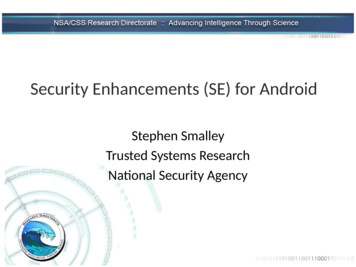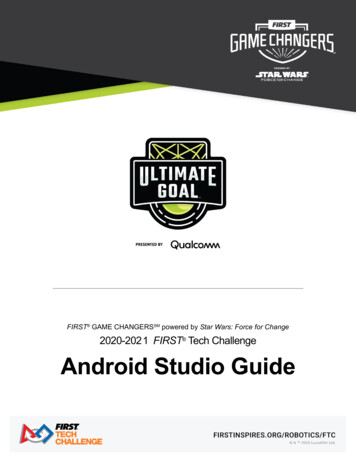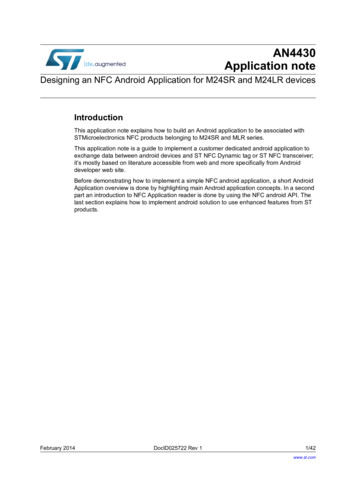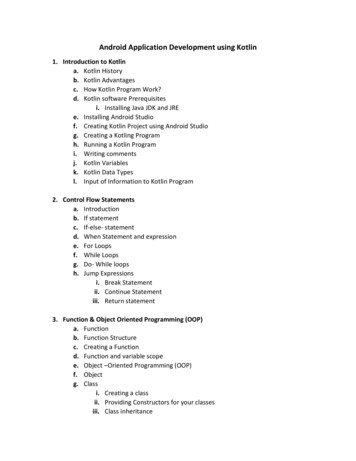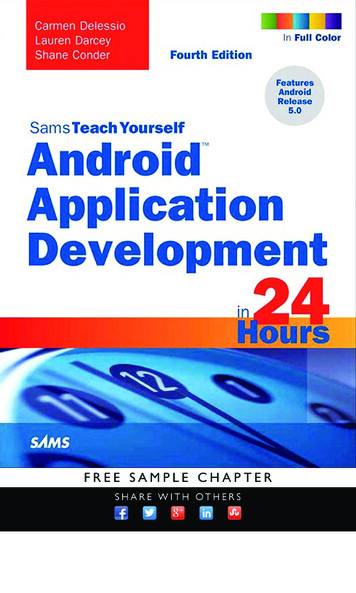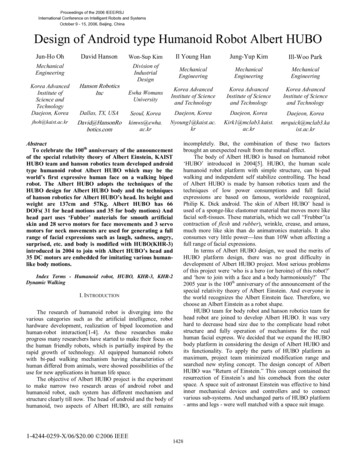
Transcription
Proceedings of the 2006 IEEE/RSJInternational Conference on Intelligent Robots and SystemsOctober 9 - 15, 2006, Beijing, ChinaDesign of Android type Humanoid Robot Albert HUBOJun-Ho OhDavid HansonWon-Sup KimIl Young HanJung-Yup KimIll-Woo ParkDivision ngineeringMechanicalEngineeringEwha WomansUniversityKorea AdvancedInstitute of Scienceand TechnologyKorea AdvancedInstitute of Scienceand TechnologyKorea AdvancedInstitute of Scienceand TechnologyMechanicalEngineeringKorea AdvancedInstitute ofScience andTechnologyDaejeon, KoreaHanson RoboticsIncDallas, TX, USASeoul, KoreaDaejeon, KoreaDaejeon, KoreaDaejeon, c.krmrquick@mclab3.kaist.ac.krAbstractTo celebrate the 100th anniversary of the announcementof the special relativity theory of Albert Einstein, KAISTHUBO team and hanson robotics team developed androidtype humanoid robot Albert HUBO which may be theworld’s first expressive human face on a walking bipedrobot. The Albert HUBO adopts the techniques of theHUBO design for Albert HUBO body and the techniquesof hanson robotics for Albert HUBO’s head. Its height andweight are 137cm and 57Kg. Albert HUBO has 66DOFs( 31 for head motions and 35 for body motions) Andhead part uses ‘Fubber’ materials for smooth artificialskin and 28 servo motors for face movements and 3 servomotors for neck movements are used for generating a fullrange of facial expressions such as laugh, sadness, angry,surprised, etc. and body is modified with HUBO(KHR-3)introduced in 2004 to join with Albert HUBO’s head and35 DC motors are embedded for imitating various humanlike body motions.Index Terms - Humanoid robot, HUBO, KHR-3, KHR-2Dynamic WalkingI. INTRODUCTIONThe research of humanoid robot is diverging into thevarious categories such as the artificial intelligence, robothardware development, realization of biped locomotion andhuman-robot interaction[1-4]. As these researches makeprogress many researchers have started to make their focus onthe human friendly robots, which is partially inspired by therapid growth of technology. AI equipped humanoid robotswith bi-pad walking mechanism having characteristics ofhuman differed from animals, were showed possibilities of theuse for new applications in human life space.The objective of Albert HUBO project is the experimentto make narrow two research areas of android robot andhumanoid robot, each system has different mechanism andstructure clearly till now. The head of android and the body ofhumanoid, two aspects of Albert HUBO, are still remains1-4244-0259-X/06/ 20.00 2006 IEEE1428incompletely. But, the combination of these two factorsbrought an unexpected result from the mutual effect.The body of Albert HUBO is based on humanoid robot‘HUBO’ introduced in 2004[5]. HUBO, the human scalehumanoid robot platform with simple structure, can bi-padwalking and independent self stabilize controlling. The headof Albert HUBO is made by hanson robotics team and thetechniques of low power consumptions and full facialexpressions are based on famous, worldwide recognized,Philip K. Dick android. The skin of Albert HUBO’ head isused of a sponge-like elastomer material that moves more likefacial soft-tissues. These materials, which we call “Frubber”(acontraction of flesh and rubber), wrinkle, crease, and amass,much more like skin than do animatronics materials. It alsoconsumes very little power—less than 10W when affecting afull range of facial expressions.In terms of Albert HUBO design, we used the merits ofHUBO platform design, there was no great difficulty indevelopment of Albert HUBO project. Most serious problemsof this project were ‘who is a hero (or heroine) of this robot?’and ‘how to join with a face and a body harmoniously?’ The2005 year is the 100th anniversary of the announcement of thespecial relativity theory of Albert Einstein. And everyone inthe world recognizes the Albert Einstein face. Therefore, wechoose an Albert Einstein as a robot shape.HUBO team for body robot and hanson robotics team forhead robot are joined to develop Albert HUBO. It was veryhard to decrease head size due to the complicate head robotstructure and fully operation of mechanisms for the realhuman facial express. We decided that we expand the HUBObody platform in considering the design of Albert HUBO andits functionality. To apply the parts of HUBO platform asmaximum, project team minimized modification range andsearched new styling concept. The design concept of AlbertHUBO was “Return of Einstein.” This concept contained theresurrection of Einstein’s and his comeback from the outerspace. A space suit of astronaut Einstein was effective to hindinner mechanical devices and controllers and to connectvarious sub-systems. And unchanged parts of HUBO platform- arms and legs - were well matched with a space suit image.
As a result, the new icon, the android type humanoidrobot Albert HUBO which may be the world’s first expressivehuman face on a walking biped robot was created through theinterdisciplinary research between different contents. It isunveiled at the APEC summit Nov. 2005 in Busan, Korea, theAlbert HUBO greeted world leaders, schoolchildren, thepublic at large, and the press media over the span of 5 days ofpresentations. Resoundingly, the Albert HUBO was the hit ofthe show at the APEC summit [U.S. News, CNN, andMSNBC, Nov. 2005].II. ALBERT HUBO: OVERALL DESCRIPTIONAlbert HUBO is our latest android type humanoid robotshown in Fig. 1. Its height and weight are 137cm and 57Kg.The robot has been upgraded from HUBO (KHR-3) platform.The body frame and the cover of KHR-3 platform aremodified to connect with android robot head. The jointcontroller, motor drive, battery, sensors and main controller(PC) are designed to be installed in the robot itself. Thespecifications of the robot is given in Table I and the DOF ofAlbert HUBO is given in Table II.Fig. 1 Android type humanoid robot Albert HUBOTABLE ISPECIFICATION OF ALBERT HUBOResearch term2005.3 2005.11Weight57KgHeight1.37mWalking Speed1.25Km/hWalking Cycle, Stride0.95sec/step, 32cm/stepGrasping Force0.5Kg/fingerDC Servo Motor HarmonicActuatorReduction Gear UnitWalking Control UnitControl UnitServo Control Unit,Communication Unit3-Axis Force Torque Sensor,FootSensorsInclinometerTorsoRate Gyro & Inclination n SectionOperating System (OS)Degrees of Freedom6V-10A for servo motors in robotheadLi-Polymer 24V-2h for motorsand circuits in robot body12V, 24V (Battery and ExternalPower Supply Changeable)Laptop computer with wirelessLANWindows XP and RTX66 D.O.F (Face and Neck parts:31 D.O.F, Body part: 35 D.O.F)TABLE IIDEGREE OF FREEDOM OF ALBERT Torso1/Kneeder2/Wrist3/ Neck(Yaw)2/Ankle1/Elbow31 DOF1 DOF8 DOF14 DOF12 DOFTotal66 DOFA. Explanation about Albert HUBO’s head.Sociable robotics emulate human facial expressions toprovide a more intuitive interface between humans and robots[6]. The actuation specifications required to emulate facialexpressions are less restricted than those of locomotion ormanipulation, but historically have been outside the range ofmobile robots. In the past, sociable robotics has usedtechnologies of entertainment robotics (or ‘‘animatronics’’) forits expressive skin materials[7-9]. Animatronic figures arebiomimetic, electro-mechanical puppets that populatenumerous themeparks and feature films.Animatronics tend to be expensive to design and build(restricting research and creativity), limited in expressivity(the faces don’t make a full range of humanlike expressions),and power hungry (limiting mobility and fusion withexpressive humanoid bodies like Hubo). Altogether, thelimitations of animatronics technology prevent expansive usein social robotics, and generally limit usefulness outside nicheapplications of films and theme parks.Animatronics’ problems of costliness, low expressivity, andpower consumption all result from the physical dissimilarityof the ‘‘skins’’ materials relative to natural human facial softtissues. The rubber/elastomer materials used in animatronicsdo not wrinkle, fold, or crease like human facial tissues. Thismeans that animatronics can’t affect a natural looking smile,frown, etc, unless the face is sculpted (and hence frozen) insuch an expression. Moreover, the elastomers used inanimatronics and other social robots require hundreds of wattsto affect a full range of expressions.To interact with people in real-world applications, roboticinteractions should be lifelike, real-time, and portable [10].To resolve these issues, author David Hanson and VictorWhite demonstrated a series of methods for making spongelike elastomer materials that move more like facial soft-tissues[11]. In particular, these techniques allow the structuring ofpore-walls in elastomer foams, so that the elastomer foamelongates much further than conventional foams, with much
lower forces than equivalent solid elastomers. The resultingmaterials, called ‘‘Frubber’’ (a contraction of flesh andrubber), wrinkle, crease, and amass, much more like skin thando animatronics materials (see figure 2). They also consumevery little power-----less than 10W when affecting a full rangeof facial expressions and speech-related mouth motions. Inearly tests, the material required less than 1/22nd the force andenergy of animatronic materials[8].The reduced energy consumption enables use with batterypowered biped walking. Being a porous, Frubber also weighsmuch less-----also a benefit for untethered walking robots. Thistechnololgy enables this first demonstration of walking,facially expressive humanoid robotics.wrist-pan, neck-pan and eyeball joints. Finger and wrist-panjoint error can not affect the whole body stability and overallmotion of arms and legs. Second type is harmonic gear. Weused it for the major joints such as leg and arm joints. It isused in neck-tilt, wrist-tilt also. Since the harmonic gear haslittle backlash on its output side, it is used in leg joints whoseerror can affect the whole system stability and joint positionrepeatability.Brushed 24V DC motors are used. It is relatively simpleto develop motor drivers than the other type motors (e.g.brushless DC motor and AC motor), which we can design itssize, shape and wiring. They also have suitable thermalproperty. When we drive them in harsh condition such as highspeed and torque, generated heat from them is not so muchcompared to that of brushless DC motors.2) Weight DistributionMain controller (PC), speakers, battery and servocontrollers/drivers for upper body are in torso as shown in Fig.3. The mass except for actuators is concentrated on torso,since we need to reduce the load which is inflicted to theactuators in frequently moving parts such as arms and legs andwe want to have large inertia of upper body for smallamplitude fluctuation of the trunk also.Fig. 2 The head of Albert HUBOAs shown in Fig. 2, Frubber is used for Albert HUBO’sskin. And 28 servo motors for face movements and 3 servomotors for neck movements are used for generating a fullrange of facial expressions such as laugh, sadness, angry,surprised, etc. Servomotors are linked with the various pointsof Albert HUBO’s face through Teflon-coated nylon strings.Therefore, the face motions are generated by drawing orreleasing the strings which are linked with achors at variousface points such as brows, eyes, Jaw, lips, Frown, and etc onAlbert HUBO’s face.To control the 31 servomotors, we use the serial servocontroller (mini SSC II, Scott Edwards Electronics). So, maincontroller sends the positions data through RS232 signals tothe serial servo controller. Then, it converts RS232 signals toPWM signals for driving the 31 servomotors. Serial servocontroller just sends the PWM signals to servomotors withoutfeedback because Servomotor has feedback control circuits inits system.B. Explanations of Albert HUBO’ body1) Actuator (Reduction Gear and DC Motor)We divided the reduction gears into 2 types as itsapplication. First type is planetary gear. We used this gear forsmall error (e.g. backlash) allowable joints such as finger,1430Fig. 3 The design of Albert HUBOIII. SYSTEM INTEGRATIONA. Distributed Control SystemThere are many peripheral devices for Albert HUBO suchas wireless LAN and CAN module, etc. By using distributedcontrol architecture, calculation burden on the main computerwas decreased in the expense of having to develop subcontrollers and communication bus lines between maincomputer and sub controllers. In addition, we have to realizereal-time capability in Windows environment becauseWindows OS is not a real-time OS. We used RTX HALextension commercial software for realizing the real-timecontrol capability in Windows environment. The RTX allowsmaking an interrupt with highest priority, which has maximumlatency of only 12usec.B. Main ControllerWe use a commercial single board computer (PCM-3370,Advantech Co.) as the main controller because it has various
peripheral interfaces, easy and fast programming environmentand also a good graphic user interface (GUI). Selectingcriterions are fast CPU speed, low power consumption,compact size and expansion interface. CPU performance ofthe main computer is about Pentium III 900 MHz.This frequency allows sufficient calculating time for the maincomputer. On the other hand, the joint motor controller dividesthe reference position into ten time slices because the controlfrequency of the joint motor control is 1 kHz (Fig. 3).C.CommunicationThe communication bus line between the main computerand the sub controllers is the means for the main computer totransmit instructions to sub controllers, or to receive data. Thecommunication speed should be fast enough to handle manysub controllers concurrently. Therefore we use CAN(Controller Area Network) protocol, which assures a highspeed serial communication up to 1Mbit/s. In CAN protocol,just two lines are needed for data transmission, therefore, it isvery simple to extend to other sub controllers.D.Sub ControllersThere are two kinds of sub controllers; the joint motorcontroller (JMC), and the inertia sensor. We developed all subcontrollers and their MPUs (Micro Processor Units) to beidentical except the serial servo controller on its head. ThisMPU has a CAN module and communicates with a maincomputer. Each controller also has several A/D converters, sowe can easily add sensors to them. Table V shows thespecification of sub-controllers.TABLE IIISPECIFICATION OF SUB -CONTROLLERSCAN Module16 bit micro controllerType 17 ch DC motor driver (48W/ch)(head, hand)5 ch A/D converter2 ch Digital outputJMCCAN Module16 bit micro controllerType 22 ch DC motor driver (400W/ch)2 ch A/D converterCAN Module16 bit micro controller1 normal force (up to 1000 N),3-Axis F/T sensor2 moments(up to 30 Nm)Strain gage amp circuitAuto balancing functionCAN Module16 bit micro controller7 ch A/D converter(2 ch for 2-axis acceleration sensorInertia sensor2ch for 2-axis rate gyro sensor1 ch for temperature sensor )Measurable range : -15 15 deg in each axisFig. 3 Motion controlV. BODY STYLING DESIGNAlbert HUBO is the first application model using HUBOplatform. It was modified body frame and cover to connectwith android robot head. ‘HUBO FX-1’ is another modelapplying HUBO platform mechanism and technology.Fig. 4 Modifying parts of HUBO PlatformIV. MOTION CONTROLAlbert HUBO has 35 DC motors and 31 servomotors. 14joint motor controllers for the DC motors of body part and 1controller for the servomotors of head part are embedded inAlbert HUBO. Since Albert HUBO has the distributed controlarchitecture, the main computer sends the reference positiondata to the joint motor controllers constantly in exactly10msec intervals (the system control frequency is 100 Hz).1431The objective of the development of HUBO and itsformer version KHR-2 [12] is the use for bi-pad walkinghumanoid robot platform to develop further excellentintelligent model. KHR-2 had no chances to use as the objectbecause it was upgraded to HUBO directly without any otherminor change process. HUBO was designed as best conditionfor humanoid robot platform which is settled the problemsoccurred in development process of KHR-2 and removedunnecessary parts in operation.The main design problem of Albert HUBO project washow to connect machine shaped body and realistic Einstein’shead naturally. The modifying of body and the making of headwere progressed concurrently. In design process, these werehad to expect and consider some errors that could be occur infinal stage of assembly process. But there is no much room forlayout design in size and space, because its base platform wasdesigned accurately. So, body layout was designed based on
CAD and image data of head mechanism excluded skin.Minimum modification parts were chest body to exchange oldhead of platform for new android head. In this process, findingthe best solutions was needed to show the well-balanced robotbecause android’s head was much bigger than that of HUBO.Some design alternatives about styling factors wereproposed for this problem. The first design alternative was aninverted triangle shape of body applying the perspectiveeffect. Artists of renaissance used perspective to expressimage more really, and modern artists distort in their art workusing perspective to present an extra effective. As ordinarypeople are good at the perspective view, they do not recognizelittle distortion about depth of perspective unless exchange alot. And as modern people are familiar with camera view orscreen through the movie camera, they recognize naturally thedistortion from lens, too. A standard adult looks down AlbertHUBO from the high view point, because he is taller thanrobot. In this case, viewer can see upper body more wide andlower body more narrow. This effect is appears more clearlyas closing the distance between viewer and robot and asraising the point of eye level. If the perspective imageobtained from the high view point is applied to the styling, aninverted triangle robot shape will be appeared (Fig. 5).Fig. 7 Design of shoulder connectionThe pelvis parts were needed to modify for the balance ofproportion and volume of whole body. Through the designmodification the figure of Albert HUBO was looks good.The second design alternative was reducing the frequencyof exposure relatively except face witch is the best importantpart in this project. To shading the back of head, the backpackof astronaut was expanded to the middle of head. Thebackpack supports protection of head from outer impact, roomfor inner mechanic parts and controllers, and base to attachvarious equipments (Fig. 8).Fig. 5 Distorted image from perspective view and its applicationIn spite of various points of view, people remind shapefrom the view of camera through the high view level. Thiscase is natural situation (Fig. 6).Fig. 8 The backpack of Albert HUBOThe third design alternative was application of effectivelighting (Fig. 9). The side lights of head were dispersedspectator’s sight concentrated on head. These powerfulhalogen lights make dramatic effect when the robot present onthe stage in the artificial fog. Additional blue LED light in theneck and the shoulder connection will be reminds feeling of amystique or fantastic mood. Specially LED light in the neckmakes shade the gap in connection between head and body,and drive spectator’s sight to the face.Fig. 6 Seeing the distorted robot, people to image shape from the view ofcameraFor expansion of upper body, arm parts were movedabout 45mm to the outside from body center. To minimize theamount of moving distance of arm parts, body cover was cutround not to interfere with shoulder (Fig. 7).1432
Fig. 9 The light of head around, shoulder connection, and the front waistACKNOWLEDGMENTMaintenance and convenience factors in robot operatingwere added in styling design process. The access mode tostandby was changed from cap type cover to hinge style. Itmade shorten ready time to operate. The Spacious inner roomof body was chocked up with head mechanisms andcontrollers. Wiring problem in HUBO platform was madeeasy using backpack side and rear pelvis. It was very hard towiring in HUBO platform. Albert HUBO has room toassemble as moving apart wiring position from near arms andlegs joints(Fig. 10).This research is mainly supported by MOCIE(Ministry ofCommerce, Industry and Energy) and partly supported by bBK-21(Brain Korea –21) project.Fig. 10 Services for hanging and wiringIn this project, serious mechanic problems or engineeringfeedback were not occurred because there were no change inarms and legs having complicated mechanism and structurethan others.VI. CONCLUSIONKAIST HUBO team and hanson robotics team developedandroid type humanoid robot Albert HUBO which may be theworld’s first expressive human face on a walking biped robot.The Albert HUBO adapts the techniques of the HUBO designfor Albert HUBO body and the technique of hanson roboticsfor Albert HUBO’s head. Its height and weight are 137cm and57Kg. Albert HUBO has 66 DOFs( 31 for head motions and35 for body motions) And head part uses ‘Fubber’ materialsfor smooth artificial skin and 28 servo motors for facemovements and 3 servo motors for neck movements are usedfor generating a full range of facial expressions such as laugh,sadness, angry, surprised, etc. and body is modified withHUBO(KHR-3) introduced in 2004 to join with AlbertHUBO’s head and 35 DC motors are embedded for imitatingvarious human-like body motions.1433REFERENCES[1] K. Hirai, M. Hirose, Y. Haikawa, and T. Takenaka, “The Development ofHonda Humanoid Robot”, in Proc. IEEE Int. Conf. on Robotics andAutomations, pp.1321-1326, 1998.[2] J. Yamaguchi, A. Takanishi, and I. Kato, “Development of a bipedwalking robot compensating for three-axis moment by trunk motion”, inProc. IEEE/RSJ Int. Conf. on Intelligent Robots and Systems, pp.561–566,1993.[3] Y. Sakagami, R. Watanabe, C. Aoyama, S. Matsunaga, N. Higaki, and K.Fujimura, “The intelligent ASIMO: System overview and integration”,in Proc. IEEE/RSJ Int. Conf. on Intelligent Robots and Systems, pp. 24782483, 2002.[4] K. Nishiwaki, T. Sugihara, S. Kagami, F. Kanehiro, M. Inaba, and H.Inoue, “Design and Development of Research Platform for PerceptionAction Integration in Humanoid Robot: H6”, in Proc. IEEE/RJS Int. Conf.on Intelligent Robots and Systems, pp.1559-1564, 2000.[5] Ill-Woo Park, Jung-Yup Kim, Jungho Lee, and Jun-Ho Oh, “MechanicalDesign of Humanoid Robot Platform KHR-3”, in Proc. IEEE-RASInternational Conference on Humanoid Robot, pp.321-326, 2005.[6] Breazeal, C. “Designing Sociable Robots”, MIT press, 2001.[7] Bar-Cohen, Y and Breazeal, C. (Ed.) “Biologically Inspired IntelligentRobotics.”, SPIE, 2003.[8] Hanson, D. Rus, D., Canvin, S., Schmierer, G., “BiologicallyInspired Robotic Applications”, in Biologically Inspired IntelligentRobotics, SPIE Press, 2003[9] Landon, R., “Entertainment Robotics”, in Biologically Inspired IntelligentRobotics, SPIE Press, 2003[10] Hanson, D, Olney, A, Zielke, M, Pereira, A. “Upending the UncannyValley”, AAAI conference proceedings, 2005[11] Hanson D., White V. “Converging the Capabilities of ElectroActivePolymer Artificial Muscles and the Requirements of Bio-inspiredRobotics”, Proc. SPIE’s Electroactive Polymer Actuators and DevicesConf., 10TH Smart Structures and Materials Symposium, San Diego,USA, 2004.[12] Jung-Yup Kim, Ill-Woo Park, Jungho Lee, Min-Su Kim, Baek-Kyu Choand Jun-Ho Oh, “System Design And Dynamic Walking Of HumanoidRobot KHR-2”, IEEE International Conference on Robotics &Automation, 2005.
HUBO team and hanson robotics team developed android type humanoid robot Albert HUBO which may be the world’s first expressive human face on a walking biped robot. The Albert HUBO adopts the techniques of the HUBO design for Albert HUBO body and the techniques of hanson robotics for Albert HUBO’s


